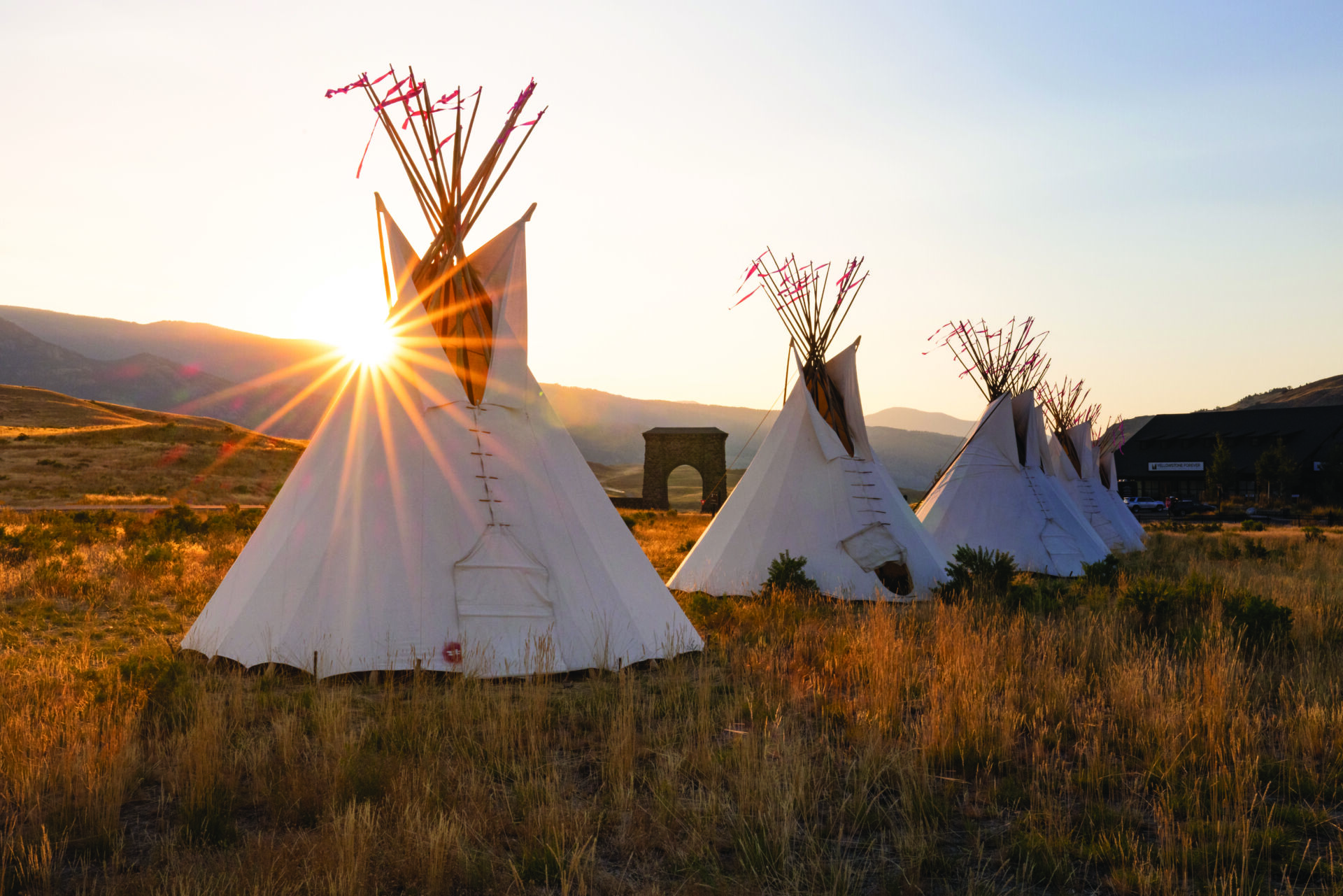Read The
Current Issue
Reconnection?
Long-excluded Indigenous residents of the Greater Yellowstone Ecosystem are seeking to forge a new, improved relationship with the national parks, forests, and other federally managed properties that sweep across their ancestral lands.
// By Mike Koshmrl
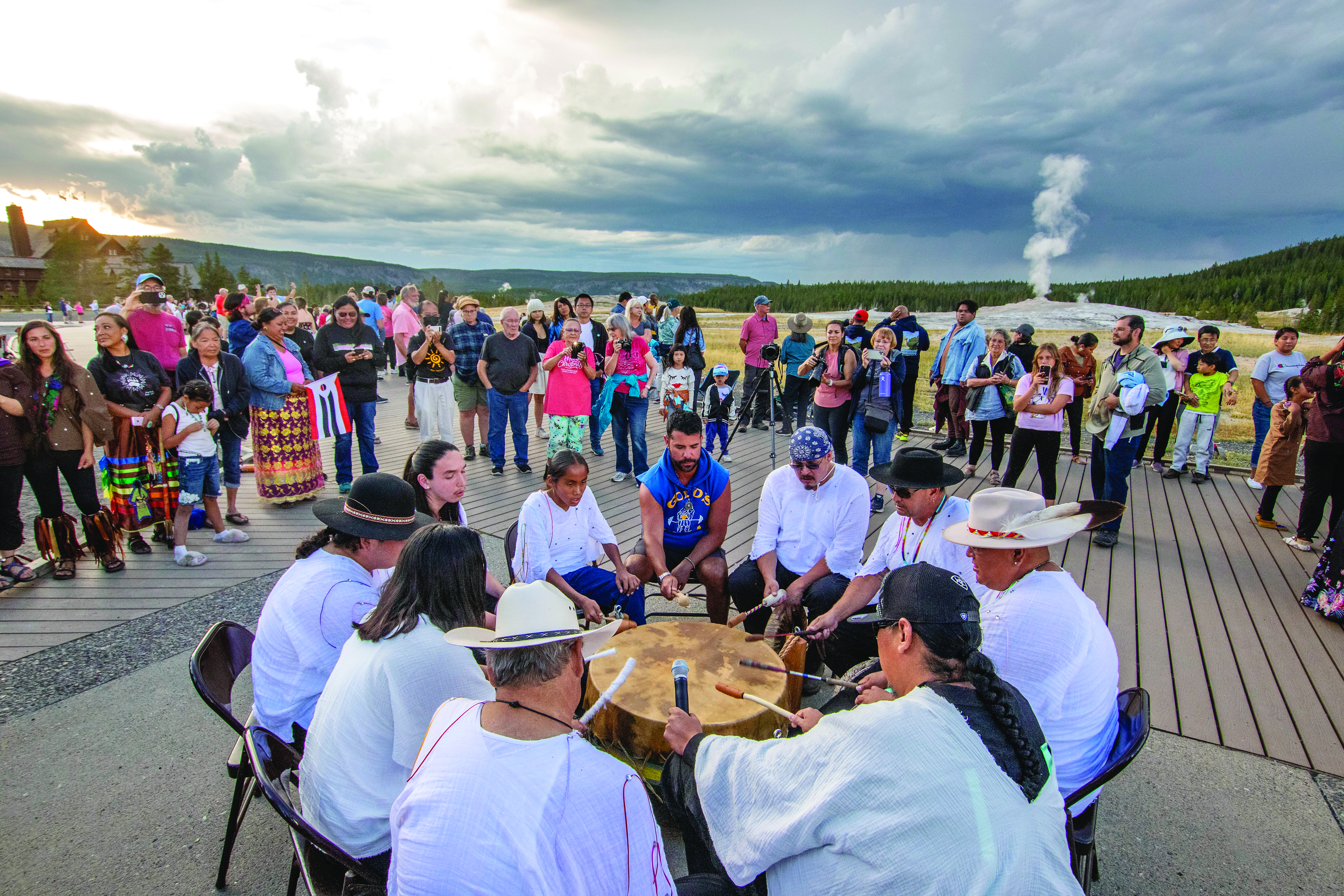
About two decades ago, Shoshone-Bannock member and attorney Jeanette Wolfley took a trip to Yellowstone National Park with a group of 20 tribal elders to help document her people’s connection to a land of steaming waters and boiling lakes. An ethnography project—which uses interviews to study people in their own environment—brought the elders into Yellowstone, which, at 151 years old, is one of the first governmentally protected areas in the world. But to the elders, the formation of the 2.2-million-acre national park represents more of the land they had used for millennia being taken away from them, an ignominious blip in a long history. Being back in their home was overwhelming to the elders, some of whom hadn’t been back there in many years, Wolfley recalled.
“One of the things they stressed is this is where they came from and it’s the beginning of our people,” Wolfley told an audience during a Yellowstone 150th panel discussion. “In our creation story, we come from the sacred waters and are molded from the mud of the Earth. The park, foremost, is our spiritual and sacred land base for the Shoshone and Bannock people.” In the modern day, Wolfley’s fellow Shoshone-Bannock tribal members mostly dwell on the Fort Hall Reservation of southeast Idaho. They were relegated to that reservation as a result of treaties that the Shoshone-Bannock signed with the U.S. government during an era when the first peoples of North America were being displaced from ancestral lands all around the American West. One of those treaties, the Virginia City treaty of 1868, was entered into by Wolfley’s great-grandfather, Chief Tendoy, who identified lands, including western Yellowstone and all of modern Grand Teton National Park, as those of his people. “That is why we continue to claim this area,” Wolfley said.
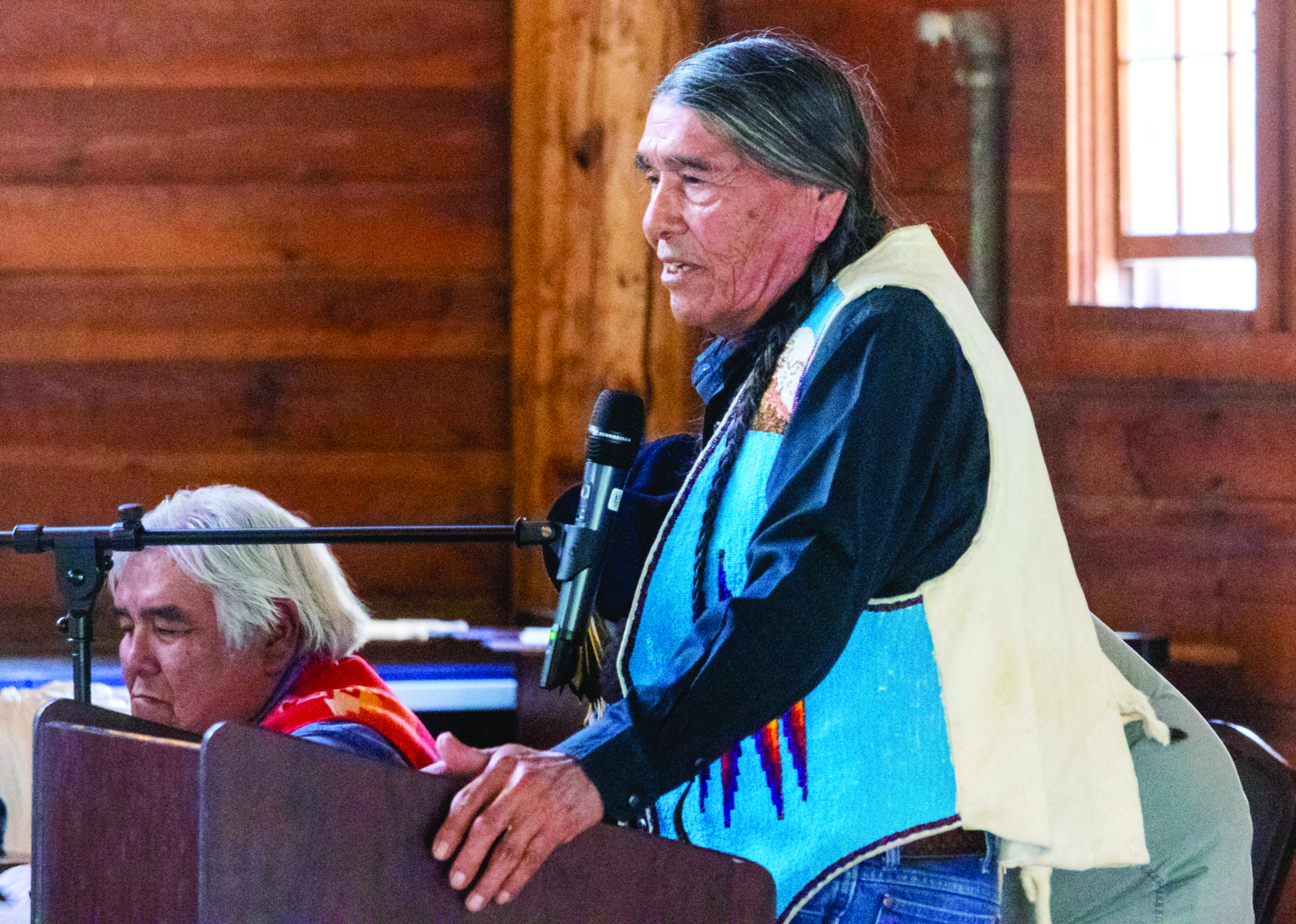
Wolfley’s remarks about the tribes’ strained relationship with the federal government that now claims the same lands comes amid an era where a movement to “re-Indigenize” the Yellowstone region is gaining steam. Legal scholars have laid out options to reverse course on a century and a half of ignoring, erasing, and marginalizing the history of Indigenous exclusion, absence, and disconnection from ancestral, now federally managed, lands. On the south end of the Greater Yellowstone Ecosystem, a Northern Arapaho tribal member is spearheading an effort to co-manage culturally significant swaths of Wyoming’s Red Desert with the Bureau of Land Management. And the Eastern Shoshone Tribe is the driving force behind a push for the state of Wyoming to recognize and accommodate off-reservation hunting on federal land—treaty-enshrined hunting rights affirmed by the 2019 landmark U.S. Supreme Court case Herrera v. Wyoming. Federal land managers, meanwhile, say they’re willing to entertain a new era of tribal relations and turn the page on a shameful chapter of American history.
“Yellowstone can once again change the world. Ultimately, re-Indigenizing Yellowstone
can restore the shine to the nation’s original crown jewel and help ensure that all
Americans can look forward to the park’s next 150 years and beyond.”
—Kekek Jason Stark, Autumn Bernhardt, Monte Mills, and Jason Robison, in the 2022 paper “Re-Indigenizing Yellowstone”
“We’ve initiated substantially increased tribal engagement going into the 150th,” Yellowstone superintendent Cam Sholly said during a celebration of the park’s anniversary. “It’s a door that’s opening. I think in some ways, it’s the easy stuff. It’s impactful, it’s meaningful—things we haven’t done before in Yellowstone—but it’s just a start.” Those efforts in 2022 included a new Yellowstone Tribal Heritage Center at Old Faithful, a rematriation ceremony, tribe-specific gatherings, and Native American art demonstrations. Tribes and the Park Service are trying to use those events as a launch pad for a more open relationship that doesn’t shy away from trying new partnerships. “That transcends the normal government-to-government relationship framework,” Sholly said. “The more that we know you and you know us and we know what you’re looking for … I think the more progress that we’re going to be able to make.”
A Wyoming Law Review article, “Re-Indigenizing Yellowstone,” was recently published giving Yellowstone a roadmap for more meaningful movement in pursuit of the goal to increase Indigenous access and influence over management. “Yellowstone can once again change the world,” authors Kekek Jason Stark, Autumn Bernhardt, Monte Mills, and Jason Robison wrote in the 2022 paper. “Ultimately, re-Indigenizing Yellowstone can restore the shine to the nation’s original crown jewel and help ensure that all Americans can look forward to the park’s next 150 years and beyond.” Looking over the broad arc of history, Yellowstone has made some headway on improving its relations with tribes. At the dawn of the 20th century, there were attempts to use Native people essentially as props to bolster tourism. One infamous example is that of an “aboriginal exhibit” at Yellowstone Lake’s Dot Island. Businessman E.C. Waters tried but “had no luck convincing any Crow to camp in the middle of Yellowstone Lake” alongside bison for the viewing pleasure of summer tourists, according to “Re-Indigenizing Yellowstone.” Over the last 30 years, federal-tribal relations in Yellowstone improved as the National Park Service and Yellowstone’s 27 associated tribes sought connection.
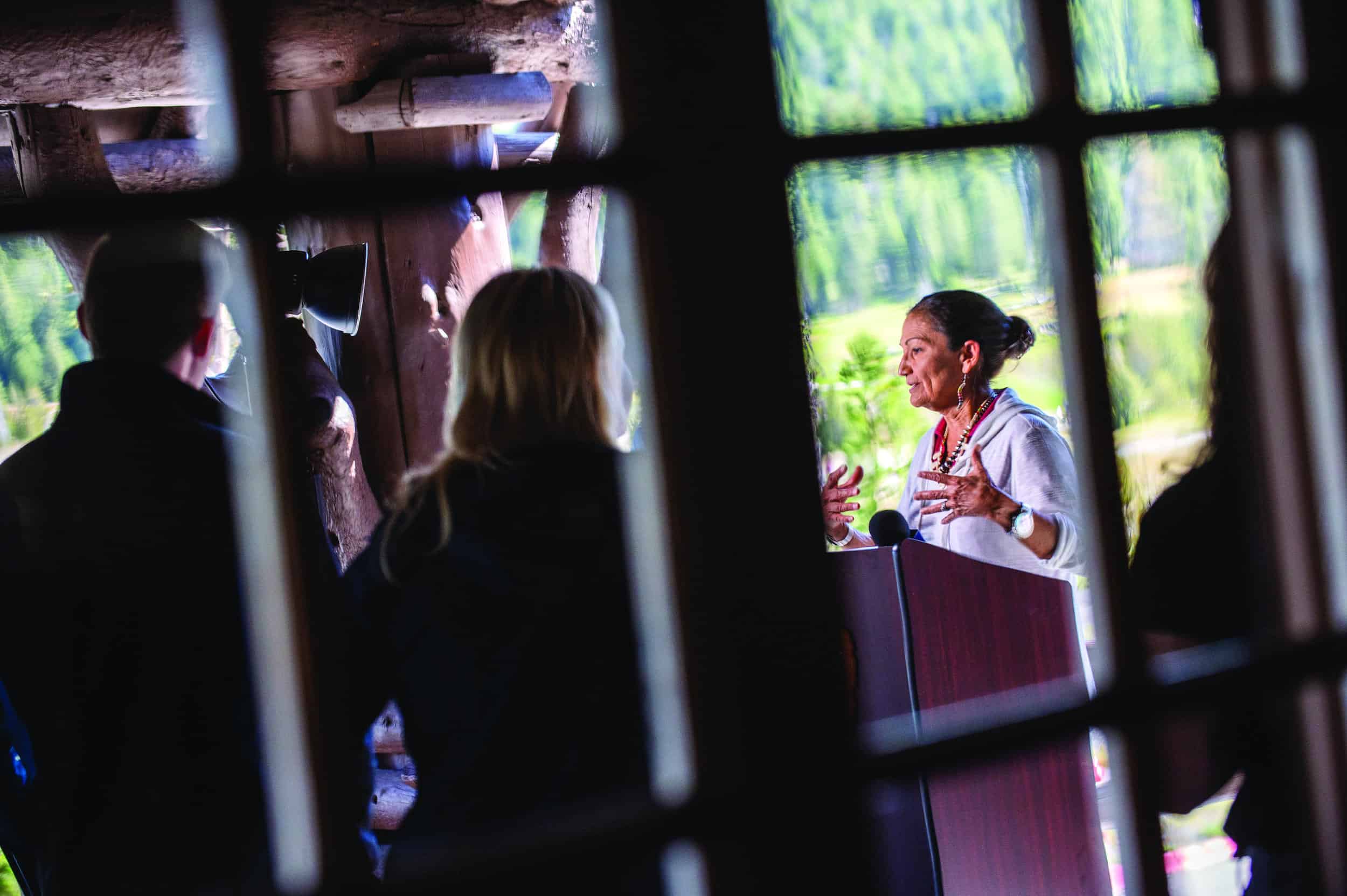
The next steps in Yellowstone’s journey to reconnect with the tribes remain unclear. There are “no significant updates to share” since the calls for change during the 150th anniversary, Yellowstone’s public affairs office informed Jackson Hole magazine. Leadership for the Eastern Shoshone, Northern Arapaho, and Shoshone-Bannock tribes were unable to be reached for this story. Native law scholars say there’s no perfect path Yellowstone can pursue, though they outline options, like the “radical realignment” the #Landback movement (see sidebar) espouses. That could mean the “undoing of the large-scale displacement of tribes” and returning of the title to Yellowstone National Park. Other options include federal-tribal government partnership models and co-management, like what’s in place at Utah’s Bears Ears National Monument, which is governed in part by an inter-tribal commission. Ultimately, Yellowstone and its associated tribes must craft their own unique partnership. “Envisioning a new management paradigm for the world’s first national park must go beyond the potential of existing collaborative frameworks to ensure it functions effectively in practice,” the “Re-indigenizing Yellowstone” authors write.
Former Eastern Shoshone Business Council member Wes Martel, who’s on staff at the Greater Yellowstone Coalition, is hopeful that the pledges of reconnection from the Park Service are more than just platitudes. Progress, he says, seems to be coming, however slowly. “There was just a lot of talk, for a year and a half,” Martel says. “Now we’re finally finding some opportunities and some resources to take action on the ground. Joe Biden and [Interior Secretary] Deb Haaland might be here not too much longer. We’ve got to get as much done as quickly as possible.” Haaland, who leads the U.S. Department of the Interior, is a member of the Pueblo of Laguna tribe who made history as the country’s first Native American cabinet member. She’s complemented by National Park Service Director Chuck Sams, the first tribal citizen to lead that federal agency. Late in 2021, Haaland signed Secretarial Order 3403, which clarified Interior’s and the U.S. Department of Agriculture’s commitment to managing federal lands and waters in a manner that seeks to “protect the treaty, religious, subsistence, and cultural interests of federally recognized Indian Tribes.” Martel cites Yellowstone’s redo of its bison-management plan as a sign of progress. The under-development plan includes an option that would allow Yellowstone’s bison population to increase to its natural carrying capacity of about 8,000 animals—against the wishes of the Montana livestock lobby and government. “It’s pretty much supporting the direction the tribes want to go,” Martel says. Where Yellowstone lands in that plan remains to be seen.
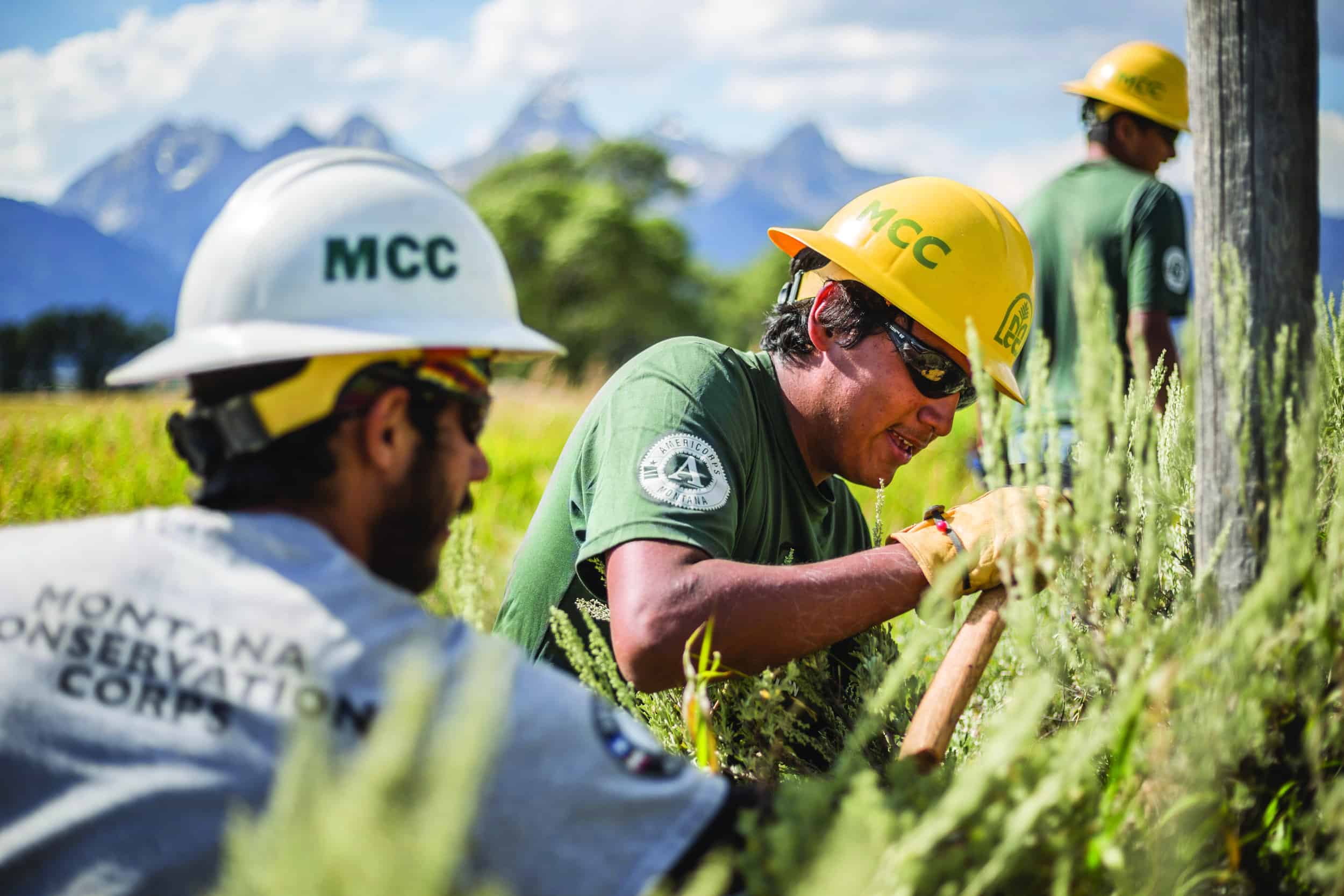
For the past 44 years, there’s been an American Indian Guest Artist Program in Grand Teton National Park. Run out of the Colter Bay Visitor Center, the 20-week-long summer program houses and provides space for 14 Native guest artists to display and sell their arts and crafts.
Elsewhere in the Greater Yellowstone Ecosystem, Indigenous advocates have primed the pump to make progress via formal policy. Yufna Soldier Wolf, a Northern Arapaho tribal member on staff at the Wyoming Outdoor Council, has led the charge on nominating 11 new “areas of critical environmental concern” in the Red Desert, a remote sweep of redrock and sagebrush south of the Wind River Range. The nominations will be reviewed by the Bureau of Land Management, which is under the oversight of Haaland’s Interior Department. Soldier Wolf told the public-interest news site WyoFile (where I’m a staff reporter) that the sites she seeks to protect include petroglyphs and other cultural resources created over centuries by tribes including the Shoshone, Ute, Bannock, Arapaho, Cheyenne, Lakota, and Crow. “A lot of times, tribes get left out on determining what should be protected and why it should be protected,” she says. The BLM’s Rock Springs Field Office is soon overhauling its resource management plan for the Red Desert, giving federal land managers a chance to improve on that exclusionary history. The door is open for the Bridger-Teton National Forest to do the same. The 3.4-million-acre national forest that flanks three sides of Jackson Hole is on the front end of redoing its own guiding plan. An Indigenous symposium to elevate tribal connections to the forest has been planned, according to Martel, and so has an inventory of important Indigenous cultural resources on the Bridger-Teton.
Martel’s successors on the Eastern Shoshone Tribe’s business council have also been behind a push to grant their sovereign members rights to hunt and fish off the Wind River Indian Reservation. That right was enumerated in their 1868 treaty, which granted the Eastern Shoshone and Shoshone-Bannock the right to hunt on “unoccupied lands of the United States,” so long as game was found and the peace was kept between Indigenous hunters and white people. For well over a century, the right was ignored—deemed extinguished by statehood and the creation of national parks, forests, and other federal lands where hunting and fishing is governed by state game laws. That changed in 2019 when the U.S. Supreme Court ruled in favor of Clayvin Herrera, a Crow tribal member who challenged the Wyoming Game and Fish Department after being charged with off-season elk hunting in the Bighorn Mountains. The high court ruled that Herrera and the Crow’s hunting rights on unoccupied, ceded lands were intact, overturning 123 years of legal precedent. The Herrera v. Wyoming decision opened the door for the Eastern Shoshone Tribe to push the state of Wyoming to grant its members off-reservation access.

The state and Eastern Shoshone sought to work it out via agreement during the Wyoming Legislature’s 2023 session, but the effort unraveled after other tribes protested. Fort Hall Business Council secretary Claudia Washakie, representing the Shoshone-Bannock, testified that stipulations in the agreement subjecting tribal members to state game laws were an affront to self-governance. “The Shoshone-Bannock Tribes have never entered into any agreements that would constrain or otherwise impede our management authority under the treaty,” Washakie said. “And we will not engage in any negotiated agreement, as laid out in the proposed legislation.” Afterward, the Eastern Shoshone pulled their own support. Eventually, the bill died. The outcome of the off-reservation hunting dispute is now left, once again, to the courtroom. Although decided in favor of Herrera, the U.S. Supreme Court tasked a Sheridan County, Wyoming, circuit court with sussing out what constitutes “unoccupied land” and whether state regulation of hunting in places like the Bighorns is necessary for conservation.
Still, cooperation—not continued conflict—is what Grand Teton National Park superintendent Chip Jenkins is striving to achieve. Along with the Yellowstone ecosystem’s other federal land managers, Jenkins is required to consult with Teton Park’s two dozen associated tribes when he proposes any major project. There’s plenty of room for improvement from the status quo. “The baseline is we send a letter, we say, ‘Hey, we’re going to do this project,’” Jenkins says. “If we don’t hear anything back, we proceed. If we hear something back, we have a conversation. It’s pretty minimal. It’s really clear from the tribes, that’s not what they’re looking for.” To remedy dissatisfaction, he’s looking into the spirit of the intention of tribal consultation—it starts with simple conversations with each tribe about priorities and needs. In those conversations, Jenkins has heard consistently from Teton-associated tribes that there’s a desire for better recognition and for the park to help reflect Indigenous history and culture. However small, the park is taking steps in that direction. “For example, at the [boat launches] at Pacific Creek and Jackson Lake Dam and here in Moose, we’re developing new interpretive exhibits,” Jenkins says. “In collaboration with the Shoshone-Bannock over at Fort Hall, we’re incorporating their language into the interpretive panels.” While readying for a Snake River float this summer, take a few minutes and learn what the Shoshone-Bannock call different types of plants and animals in their native tongue.
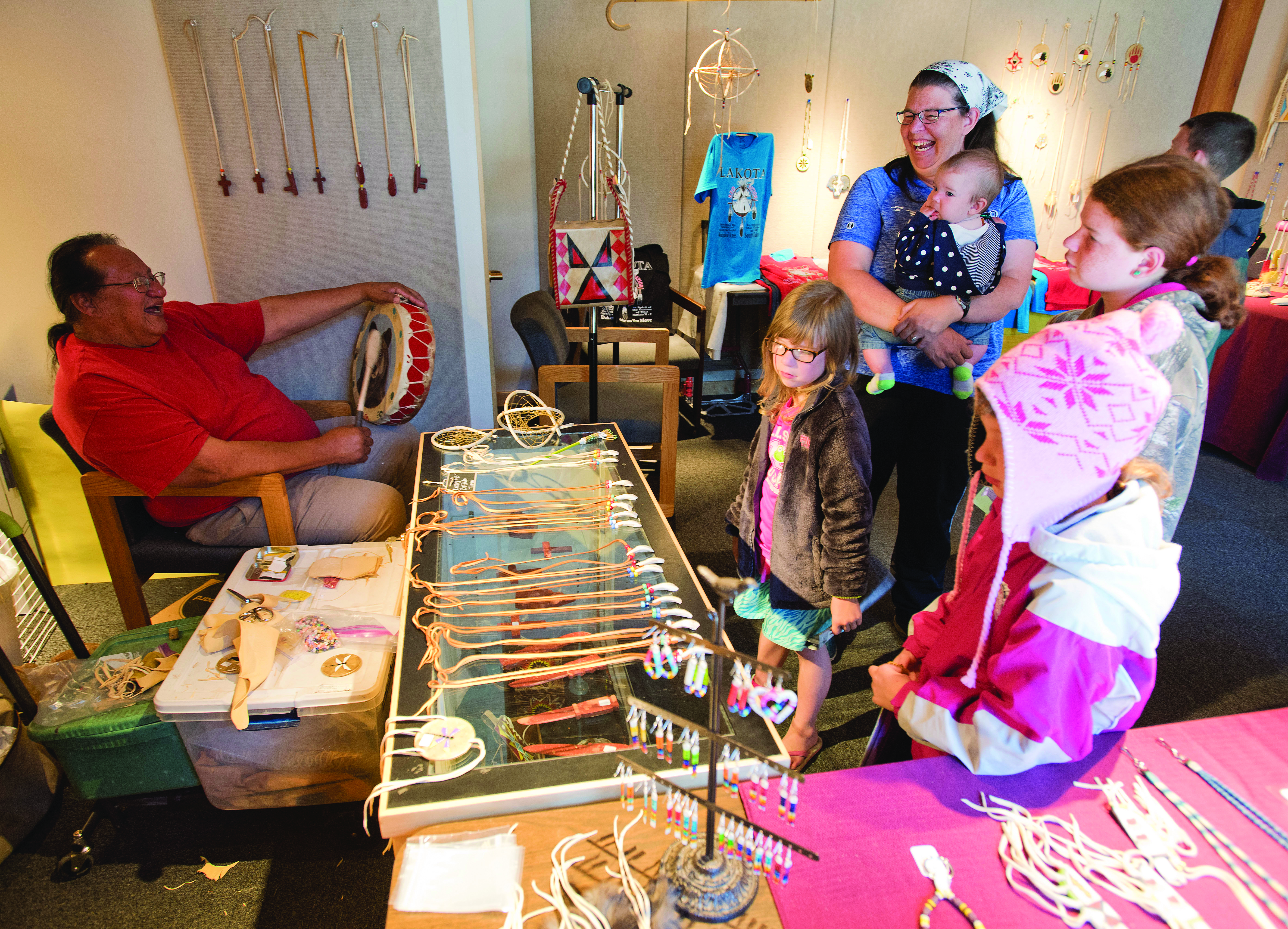
Teton Park is also promoting Indigenous reconnection to its 310,000 acres by facilitating tribal members spending time in the park from which their forebears were expelled. Admission to Grand Teton National Park is free for any members of the park’s associated tribes, but there are more concerted efforts to get the park’s first people out to see the Tetons once again. For the past 44 years, there’s been an American Indian Guest Artist Program. Run out of the Colter Bay Visitor Center, the 20-week-long summer program houses and provides space for 14 Native guest artists to display and sell their arts and crafts. For the past eight years, the park has also hosted a paid internship program, the Tribal Youth Corps, with support from the Grand Teton National Park Foundation. “We’re putting a real effort in to try to connect with the Wind River Indian Reservation,” Jenkins says. There are outreach efforts targeted at getting tribal members from the west out to Grand Teton, too. For the past nine years, the National Park Service’s Every Kid in a Park program has brought in fourth grade students from Blackfoot, Idaho, a community on the outskirts of the Shoshone-Bannock’s Fort Hall Reservation. “Blackfoot, it’s not that far away, but many of those kids have never come over here,” Jenkins says.
The outreach programs are one small step in the right direction, but Jenkins knows there’s a long way to go. “I’ve been hearing from tribal leaders and tribal elders that they’re looking for more collaboration, coordination, and co-stewardship,” he says. “We’re interested in having conversations about that; it’s unclear what that means, right? But that’s part of what needs to go on to maintain the existing tribal relationships we have and also work to build more.”
Affiliated tribes of Yellowstone and Grand Teton national parks
Apache Tribe**
Assiniboine and Sioux
Blackfeet
Burns Paiute**
Cheyenne River Sioux*
Cheyenne and Arapaho of Oklahoma**
Coeur d’Alene
Comanche
Colville Reservation
Crow
Crow Creek Sioux*
Eastern Shoshone
Flandreau Santee Sioux*
Gros Ventre and Assiniboine
Kiowa
Kootenai**
Little Shell Chippewa*
Lower Brule Sioux*
Nez Perce
Northern Arapaho
Northern Cheyenne
Oglala Sioux
Rosebud Sioux
Salish and Kootenai
Shoshone–Bannock
Sisseton Wahpeton*
Spirit Lake*
Standing Rock Sioux
Turtle Mountain Band of the Chippewa*
Umatilla Reservation
Confederated tribes of the Yakama Nation**
Yankton Sioux
* Denotes tribes only associated with
Yellowstone National Park
**Denotes tribes only associated with
Grand Teton National Park
#Landback Movement
Landback—a word often deployed with a hashtag—is a movement that demands the return of all lands taken from Indigenous peoples. In the United States, Landback picked up steam in 2020 after protesters blocked the highway that then-president Donald Trump was taking to access Mount Rushmore, a defaced part of the Black Hills, which is a sacred place to the region’s Indigenous Lakota people.
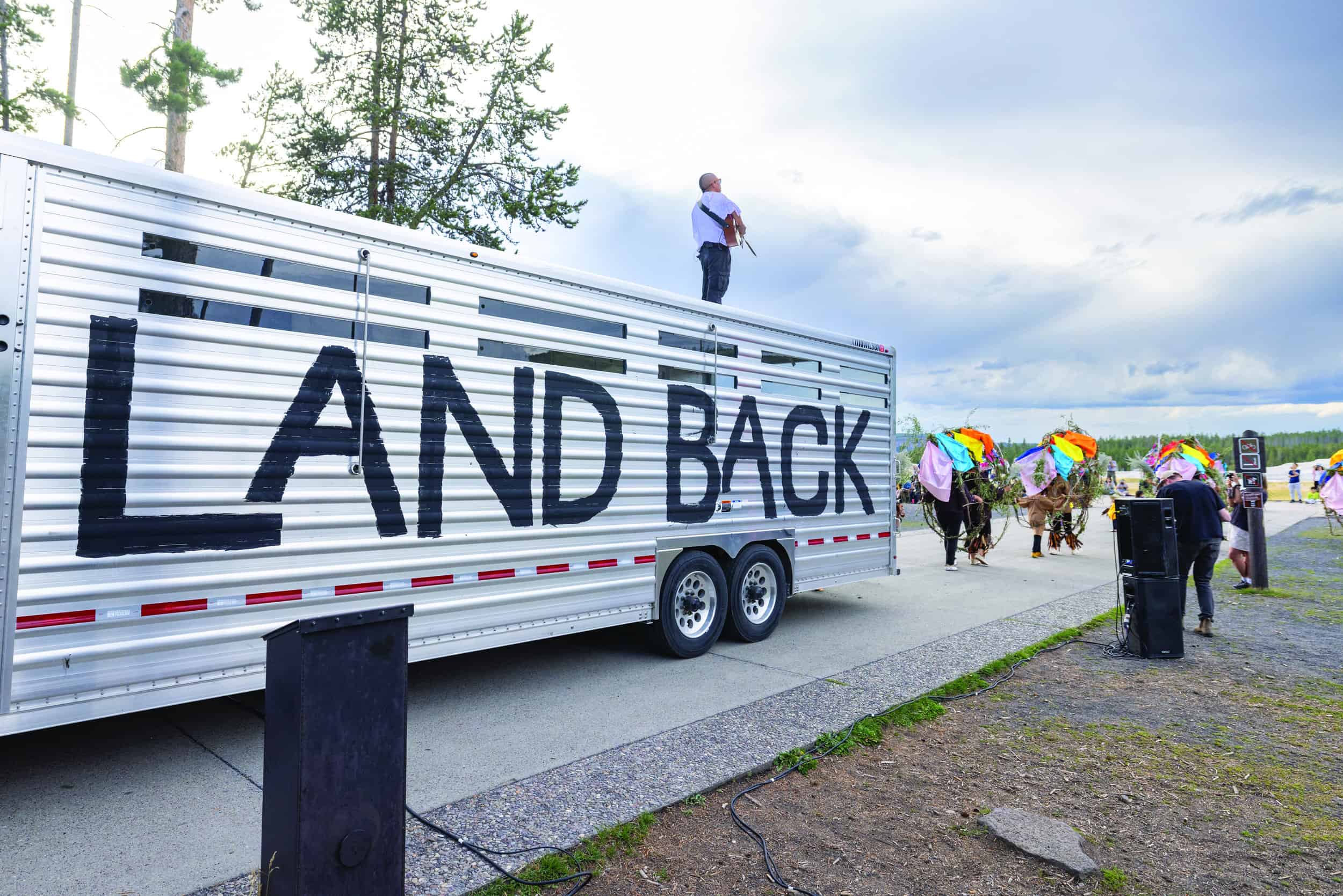
According to the Wyoming Law Review article “Re-Indigenizing Yellowstone,” landback carries a “kaleidoscope of meanings and often the baggage of misunderstanding.” To some, the term means a return of land to tribal stewardship and a “restoration of Indigenous land relationships.”
While it’s perhaps unlikely that Yellowstone or other reaches of the ecosystem are outright conveyed to its associated tribes anytime soon, the restoration of lands to tribal ownership is not unprecedented. In December 1970, former Republican President Richard M. Nixon returned tens of thousands of acres in the mountains east of Taos, New Mexico, to the Taos Pueblo people. “This is a bill that represents justice, because in 1906 an injustice was done in which land involved in this bill, 48,000 acres, was taken from the Indians involved,” Nixon said at the time. “I can’t think of anything more appropriate or any action that could make me more proud as President of the United States.” JH

